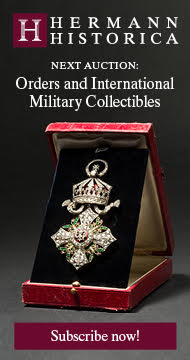Order of Ludwig, II Class Knight's Cross (in silver gilt)
CATEGORY: Version
SKU: 01.HSD.0102.108.01.001
Estimated market value:

Estimated market value:
A Maltese cross constructed of silver gilt and enamels. The arms of the cross are in black enamel with red enamel borders and the edges of the arms are in silver gilt. The obverse centre bears a circular medallion with a central "L" monogram encompassed by an open ended laurel wreath on a red enamel background, encompassed by a white enamel border with the inscription "FÜR VERDIENSTE" (for merit). The reverse centre bears a circular medallion with the inscription "GOTT EHRE VATERLAND" (God Honour Fatherland) on a black enamel background, encompassed by a white enamel border with a wreath of laurel and oak. The cross is topped with a crown suspension on a loop, on a black and red ribbon.
The Order of Ludwig was founded by Grand Duke Ludwig I on August 25, 1807 as an order without a name or statutes. In 1831, the Grand Ducal House and Merit Order was renamed the Order of Ludwig and received new statutes. It was not until December 14, 1837 that statues were adopted and the order was given a formal title. The order was divided into five classes including Grand Cross, I Class Commander, II Class Commander, I Class Knight, and II Class Knight. Membership of each class of the order was not limited. The Grand Master of the Order of Ludwig was always the Grand Duke and he alone was entitled to appoint members. Grand Crosses were reserved for persons of princely birth or a comparable rank. An order chancellery for the Order of Ludwig was established and all the business regarding the order was taken care of by the chancellery.
In 1853, the Order of Ludwig was expanded and the Gold and Silver Medals were added as grades. In 1854, Grand Duke Ludwig III added a statute to the order that if a member was guilty of an unworthy behavior, they could no longer use the insignia of the order in their coat of arms or title. In 1860, Grand Duke Ludwig III established detailed instructions for wearing the order. In 1912, Grand Duke Ernst Ludwig revised the statutes. Instead of a Knight's Cross I and II Class, he instead established the Honor Cross and the Knight's Cross. In 1917, on the occasion of his 25th anniversary in government, Grand Duke Ernst donated the Collar of the order. The princes of the Grand Ducal House would receive the Collar on their 21st birthdays. It could also be awarded to princes of a ruling house who married a princess of the Grand Ducal Hesse. The collar was only worn on special occasions.
Upon a recipient's death, the order had to be returned to the chancellery. If a member received a higher class of the order, the lower class had to be returned. Recipients of the Order of Ludwig were required to add the dignity received to their coat of arms.
The Order of Ludwig was primarily conferred upon individuals in recognition of civil merit, but following the outbreak of the First World War, it also became an award for military merit. Awards conferred for military merit featured crossed swords. The order grades were conferred with diamonds to recognize exceptional merit.
The Order became obsolete in 1918, following the abdication of the last Grand Duke of Hesse.
The II Class Knight was renamed Knight in 1912.

Comments
Sign in to comment and reply.


Scroll Top